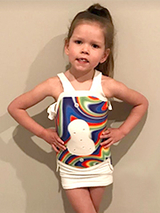Casting to Treat Scoliosis and Foot Deformities: Paisley’s Story
Casting to Treat Scoliosis and Foot Deformities: Paisley’s Story
Paisley was just a toddler when her family learned she had scoliosis, a condition that caused her spine to curve and would progressively worsen as she grew. If left untreated, her condition would affect her posture, her growth and her movement. Her family found treatment and hope at Children’s Hospital of Philadelphia (CHOP). Here, Paisley’s mom, Stephanie, shares her daughter’s story.

When we first learned Paisley had infantile scoliosis, we were in disbelief. Would Paisley still be able to be a “normal” kid and participate in things like dance or climb on the playground?
We remember sitting in an exam room with Patrick J. Cahill, MD, discussing the possibility of starting Paisley in serial casting, a non-invasive treatment used to slowly straighten the spine. We were given the option to begin serial casting right away or “wait and see” if Paisley’s condition would worsen.
My husband and I were distraught. My husband turned to Dr. Cahill and asked point-blank, “If this was your child, what would you do?” Dr. Cahill didn’t hesitate: He said he would do the casting. We trusted his expertise and we started casting on Paisley soon after.
Feet first
We initially brought Paisley to CHOP when she was 4 months old. Her feet had started to turn in, and we learned she had a foot deformity. Jennifer Winell, MD, an attending physician with the Orthopedic Center, examined Paisley and astutely discovered our daughter also had a significant curve in her spine.
The dual deformities raised Dr. Winell’s suspicions that our daughter may have additional issues with her spinal cord and promptly ordered an MRI to see if she had a muscle imbalance. Thankfully, these issues were unrelated and not symptoms of a larger syndromic condition.
Dr. Winell turned her focus to treating Paisley’s feet, and used serial casting to correct the foot deformities. Paisley had four different casts on her feet over several months – slowly moving her feet into a more natural alignment – before treatment switched to bracing to ready her body for walking.
Throughout Paisley’s foot realignment process, Dr. Winell closely monitored her scoliosis. The curve was first measured at 25 degrees. It’s not unusual for babies to have mild spinal curves from their time in utero. Nearly 80% of mild spinal curves (less than 35 degrees) get better as the child grows and do not need intervention.
However, Paisley’s spinal curve was stubborn. Instead of improving as she grew, her scoliosis got worse.
Spine correction
Dr. Winell referred Paisley and her family to Dr. Cahill, an orthopedic surgeon with expertise treating spinal deformities in children. Dr. Cahill examined Paisley and reviewed her X-rays. He discovered that although the degree of Paisley’s spinal curve hadn’t worsened significantly, it had become multidimensional. Instead of Paisley’s spine merely curving to one side, it was now twisting inside her chest, affecting her spine, ribs and organs.
It was back to casting for Paisley. This time, however, she was fitted for a brace that would cover her entire torso, from just under her armpits to her hip bones. Dr. Cahill and the spine team of Jason R. Smith, PA-C, MPT, ATC, and Joseph Monteleone, cast room technician, encouraged us to begin casting as early as possible because results are best if started before 18 months of age.
We agreed, and soon after Paisley was put under anesthesia to begin the process.
Creating the initial cast
Creating a cast to treat scoliosis requires coordinated care to apply an elaborate contraption that includes straps to the hips and head in order to stretch the spine out. While the spine is held in traction, a padded cast is simultaneously applied while a three-person casting team carefully untwists the child’s spine.
Once the cast is hardened in the desired position, the traction is released and the cast is further customized to make it more comfortable for the child to wear for long periods of time. The cast is also padded for comfort as Paisley would need to wear it for two months at a time.
We learned very quickly how resilient our little girl is. The casts and braces never held her back. Of course, she had moments with tantrums and wanting her cast off, but she quickly adapted. Paisley learned how to do almost everything she wanted – climbing, dancing, riding a bike, but summer was tough. She had to avoid typical summer activities like pool parties and trips to the beach.
After four serial casts, Paisley’s spinal curve was fully corrected – even without the cast on. She was put into a soft brace that mimicked the cast for another year and her scoliosis did not return. Slowly, she began to use the brace less and less.
Considered ‘cured’ of scoliosis

Today, Paisley has been brace-free for about 6 months and her scoliosis is considered cured. While not all children who receive casting for scoliosis are permanently cured, as many as 60% are. We consider ourselves lucky.
The road we traveled wasn’t an easy one, but it was the right one for Paisley. We always knew she was the best of hands and that she was getting the best care possible at CHOP. Her outcome proved us right.
We are beyond thankful to CHOP for curing our daughter. We cannot thank Dr. Cahill, Jason Smith and the whole team enough!
– Stephanie B., Paisley’s mom
Written 12/2020